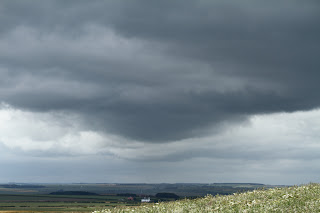Loads of Common Blue damselflies, butterflies doing what they do, flying! The only one I photographed was this Meadow Brown which I quite like on the yellow flowers. I did see a pair of Ringlets mating but too dark to photo.
There were lots of the caterpillars of the Cinnabar Moth. Caterpillars are most evident when ragwort is in full flower. The caterpillar stage lasts about 1 month during which time it undergoes 5 moults.
When fully fed the caterpillars crawl away from the plants to
pupate in a dry sheltered spot such as among the debris at the base of the
plants or into crevices under logs, stones and lumps of earth.
The pupal stage is prolonged
lasting about 9 months, and the moths do not emerge again until the
following spring.
High losses can occur in winter if pupation sites are
waterlogged, as pupae cannot stand prolonged immersion in water, although they
can survive considerable desiccation.
graph.The foilage is being eaten voraciously!










